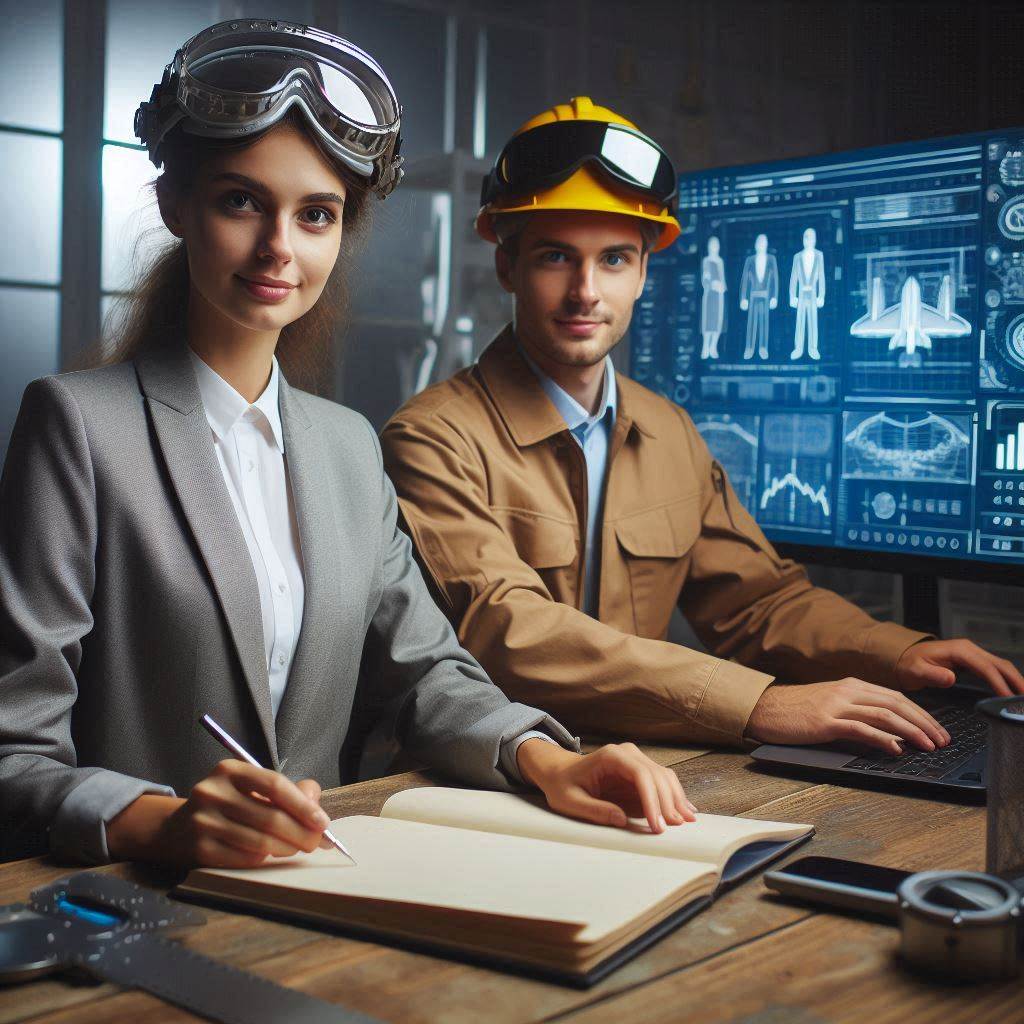Introduction
Aerospace engineering is a branch of engineering that focuses on the design, development, and maintenance of aircraft and spacecraft.
It combines principles of mechanical engineering, materials science, and computer science to create technologies that operate both within Earth’s atmosphere and beyond.
In recent years, commercial spaceflight has emerged as a groundbreaking development in the aerospace industry.
This sector involves private companies working to make space travel accessible to non-governmental entities, including private individuals, businesses, and research organizations.
Aerospace engineering plays a crucial role in advancing commercial spaceflight by providing the technical expertise needed to develop and refine spacecraft, launch systems, and supporting technologies.
Engineers in this field work on solving complex challenges related to spacecraft design, propulsion systems, life support, and re-entry, which are essential for the success and safety of commercial space missions.
Their contributions drive innovation, reduce costs, and improve the feasibility of space travel, paving the way for a new era of exploration and opportunity beyond our planet.
History of Aerospace Engineering in Commercial Spaceflight
Early Developments
Early developments in aerospace engineering for commercial spaceflight laid the groundwork for today’s advancements.
In the mid-20th century, the space race sparked initial interest in commercial space exploration.
The launch of Sputnik by the Soviet Union in 1957 marked the beginning of space technology development.
This era saw the creation of foundational technologies for space travel.
In the 1960s and 1970s, the Apollo program advanced spacecraft design and technology.
NASA’s achievements, including landing humans on the Moon, demonstrated the feasibility of space missions.
These early missions provided critical insights into spacecraft engineering and operations.
The 1980s brought the introduction of the Space Shuttle program, which aimed to make spaceflight more routine and cost-effective.
The shuttle’s reusable design was a significant milestone.
It marked the transition from single-use rockets to reusable spacecraft, paving the way for future commercial ventures.
Milestones in the Field
Several milestones have defined the evolution of aerospace engineering in commercial spaceflight.
In 2004, Burt Rutan’s SpaceShipOne won the Ansari X Prize.
This achievement was the first privately funded spacecraft to reach space, proving the viability of commercial spaceflight.
The launch of SpaceX’s Falcon 1 in 2006 marked the first privately funded liquid-fueled rocket to reach orbit.
SpaceX’s successful missions demonstrated that private companies could achieve spaceflight milestones previously reserved for government agencies.
Another milestone came with SpaceX’s Falcon 9 rocket. In 2015, it became the first orbital-class rocket to land vertically after launch.
This achievement was a significant advancement in reusable rocket technology and cost reduction.
The development of the Crew Dragon spacecraft by SpaceX also marked a significant milestone.
In 2020, it became the first privately operated spacecraft to transport astronauts to the International Space Station.
This achievement demonstrated the maturity of commercial spaceflight technologies and their readiness for human space missions.
Evolution of Technologies and Designs
Technologies and designs in aerospace engineering for commercial spaceflight have evolved significantly.
Early spacecraft were simple and designed for single-use missions.
Today’s spacecraft incorporate advanced materials and technologies for increased efficiency and safety.
The shift towards reusable rocket technology represents a major evolution.
Rockets like SpaceX’s Falcon 9 and Blue Origin’s New Shepard are designed for multiple flights.
Reusability reduces costs and increases the frequency of space missions, making commercial spaceflight more accessible.
Advancements in propulsion systems also play a crucial role.
Newer engines, such as SpaceX’s Raptor and Blue Origin’s BE-4, offer improved performance and fuel efficiency.
These engines enable longer and more ambitious space missions.
Satellite technology has also evolved.
Modern satellites are smaller, more capable, and cost-effective compared to their predecessors.
Innovations in satellite design allow for more efficient communication, Earth observation, and scientific research.
Basically, early developments in aerospace engineering set the stage for commercial spaceflight.
Milestones such as SpaceShipOne and Falcon 9 highlighted the potential of private space ventures.
The evolution of technologies and designs, including reusable rockets and advanced propulsion systems, continues to drive progress in commercial spaceflight.
Role of Aerospace Engineers in Commercial Spaceflight
Responsibilities and Duties
Aerospace engineers in commercial spaceflight handle a range of critical responsibilities.
They design and develop spacecraft and launch systems, ensuring that these technologies meet mission requirements.
Engineers work on spacecraft components, propulsion systems, and avionics to guarantee reliability and performance.
Engineers also oversee the testing and validation of new technologies.
They conduct simulations and physical tests to verify that systems function correctly under various conditions.
Ensuring safety and compliance with regulations is another crucial duty, involving rigorous analysis and documentation.
Another key responsibility is troubleshooting and problem-solving during spacecraft operations.
Engineers must quickly address and resolve any issues that arise during development, testing, or actual missions.
They also collaborate on mission planning, helping to design and optimize flight trajectories and mission profiles.
Additionally, engineers work on improving existing technologies.
They seek ways to enhance efficiency, reduce costs, and increase the sustainability of spaceflight operations.
Continuous improvement is vital for maintaining competitive advantage and advancing the field.
Collaboration with Other Professionals
Aerospace engineers frequently collaborate with other professionals in the industry.
They work closely with scientists to understand mission objectives and requirements.
Scientists provide insights into experimental goals, data analysis, and specific mission needs.
Engineers also coordinate with project managers to ensure that development stays on schedule and within budget.
Effective communication and project management skills are essential for successful collaboration.
Managers handle the overall project, while engineers focus on technical details.
Additionally, engineers collaborate with manufacturers and suppliers to source materials and components.
They ensure that parts meet quality standards and integrate seamlessly into the spacecraft.
Coordination with these partners is crucial for maintaining production schedules and quality.
Transform Your Career Today
Unlock a personalized career strategy that drives real results. Get tailored advice and a roadmap designed just for you.
Start NowEngineers often interact with regulatory agencies to ensure compliance with industry standards and safety regulations.
They provide technical expertise and documentation required for approvals and certifications.
This collaboration helps navigate the complex regulatory landscape of commercial spaceflight.
Skills and Qualifications
A successful career in aerospace engineering for commercial spaceflight requires specific skills and qualifications.
A bachelor’s degree in aerospace engineering or a related field is essential.
Advanced degrees or specialized certifications can enhance career prospects and opportunities.
Strong technical skills are crucial. Engineers must have a deep understanding of propulsion systems, avionics, and materials science.
Proficiency in computer-aided design (CAD) and simulation software is also important for designing and testing spacecraft.
Problem-solving and analytical skills are key to addressing complex engineering challenges.
Engineers must be able to analyze data, develop solutions, and implement changes effectively.
Attention to detail and a methodical approach are essential for ensuring accuracy and reliability.
Excellent communication and teamwork skills are vital.
Engineers need to collaborate with various professionals and clearly convey technical information.
Project management skills can also be beneficial, as engineers often work on large-scale projects with tight deadlines.
Therefore, aerospace engineers in commercial spaceflight handle design, testing, safety, and improvement of spacecraft technologies.
They collaborate with scientists, managers, manufacturers, and regulatory bodies.
A successful career requires a relevant degree, technical skills, problem-solving abilities, and strong communication and teamwork skills.
Advancements in Aerospace Engineering for Commercial Spaceflight
Recent Breakthroughs and Innovations
Recent breakthroughs and innovations are reshaping aerospace engineering for commercial spaceflight.
One significant advancement is the development of reusable rocket technology.
Companies like SpaceX have pioneered the reuse of rocket stages, drastically reducing launch costs and increasing mission frequency.
This innovation has transformed the economics of spaceflight.
Another breakthrough involves advancements in propulsion systems.
New technologies, such as more efficient rocket engines and advanced ion thrusters, are enhancing spacecraft performance.
These innovations enable longer missions and improve fuel efficiency, which is crucial for deep-space exploration.
Additive manufacturing, or 3D printing, is also making an impact.
Engineers use 3D printing to create complex spacecraft components quickly and cost-effectively.
This technology allows for rapid prototyping and customization, accelerating the development process.
Satellite technology has also seen significant improvements.
Miniaturization and advancements in satellite design are enabling more capable and versatile spacecraft.
Smaller, more efficient satellites can now perform a range of functions previously reserved for larger, more expensive satellites.
Impact of New Technologies
New technologies are significantly enhancing the efficiency and safety of commercial spaceflight.
Reusable rockets reduce the cost of access to space, making it more accessible for commercial ventures.
This advancement supports a growing number of private missions and satellite launches.
Improved propulsion systems increase the efficiency of space travel.
Enhanced engines and thrusters enable longer-duration missions and more precise orbital insertions.
These advancements contribute to successful mission outcomes and expand the range of possible space missions.
Additive manufacturing enhances safety by allowing for the rapid production of high-quality, customized parts.
This technology reduces manufacturing errors and accelerates the testing of new components.
Engineers can quickly iterate designs and address issues before they impact mission safety.
Smaller, advanced satellites offer improved functionality and reliability.
Their reduced size and weight mean they can be launched more easily and at lower costs.
This development supports a broader range of applications, from Earth observation to communications.
Future Trends and Developments
Looking ahead, several trends and developments will shape the future of aerospace engineering for commercial spaceflight.
One trend is the increasing focus on interplanetary travel.
Engineers are working on technologies for missions to Mars and beyond, including advanced propulsion systems and life support technologies.
Another emerging trend is the development of space tourism.
Companies are designing spacecraft specifically for suborbital and orbital space tourism experiences.
This industry promises to expand the market for commercial spaceflight and create new business opportunities.
The integration of artificial intelligence (AI) and machine learning into spacecraft systems is also on the horizon.
AI can enhance navigation, diagnostics, and autonomous operations, improving mission efficiency and safety.
These technologies will play a key role in the future of space exploration.
Finally, there is a growing emphasis on sustainable space operations.
Innovations aimed at reducing space debris and minimizing the environmental impact of space activities are gaining traction.
Sustainable practices will be crucial for the long-term viability of commercial spaceflight.
In fact, recent breakthroughs in reusable rockets, propulsion systems, additive manufacturing, and satellite technology are transforming commercial spaceflight.
These innovations improve efficiency and safety, while future trends such as interplanetary travel, space tourism, AI integration, and sustainability will drive further advancements in aerospace engineering.
Read: Impact of Local Building Codes on US Architecture.
Transform Your Career Today
Unlock a personalized career strategy that drives real results. Get tailored advice and a roadmap designed just for you.
Start NowChallenges and Limitations in Aerospace Engineering for Commercial Spaceflight
Technical Challenges Faced by Aerospace Engineers
Aerospace engineers encounter numerous technical challenges in commercial spaceflight.
One major challenge is developing reliable rocket propulsion systems.
Engineers must design engines that provide sufficient thrust while maintaining efficiency and safety.
Achieving this balance involves complex materials and advanced technologies.
Another challenge is ensuring spacecraft durability.
Spacecraft must withstand extreme temperatures, vacuum conditions, and high radiation levels.
Engineers use specialized materials and rigorous testing to ensure spacecraft can endure these harsh conditions.
Designing for reusability presents its own set of challenges.
Reusable rockets must be engineered to withstand multiple launches and landings.
This requires innovations in materials, engineering, and maintenance procedures to ensure safety and performance over multiple missions.
Systems integration is also a critical challenge.
Spacecraft systems, such as avionics, propulsion, and thermal controls, must work seamlessly together.
Engineers face the task of ensuring that all systems function harmoniously during complex missions.
Regulatory Constraints and Safety Concerns
The commercial spaceflight industry faces significant regulatory constraints.
Governments and international bodies impose regulations to ensure safety and mitigate risks.
Compliance with these regulations is essential for obtaining launch licenses and operating legally.
Safety concerns are paramount in aerospace engineering.
Ensuring the safety of crew and cargo involves rigorous testing and adherence to safety protocols.
Engineers must address potential hazards, such as launch failures, in-flight anomalies, and re-entry issues.
Environmental regulations also impact commercial spaceflight.
Engineers must comply with standards aimed at minimizing environmental impact, such as reducing rocket emissions and managing space debris.
These regulations shape design choices and operational practices.
Strategies for Overcoming Obstacles
Overcoming technical challenges requires innovation and collaboration.
Engineers continuously explore new materials, technologies, and designs to improve performance and safety.
Collaborations between aerospace companies and research institutions drive advancements and solutions to complex problems.
Adopting modular designs can enhance reusability and simplify maintenance.
Modular spacecraft components allow for easier upgrades and repairs, reducing costs and improving reliability.
This approach supports the development of reusable rockets and spacecraft.
Enhanced testing and simulation techniques are vital.
Engineers use advanced simulations to model spacecraft behavior under various conditions.
Rigorous testing, including simulated space environments, helps identify potential issues before actual missions.
Addressing regulatory constraints involves proactive engagement with regulatory agencies.
Aerospace companies work closely with regulators to ensure compliance and influence policy development.
This collaboration helps streamline approval processes and adapt regulations to emerging technologies.
Industry-wide collaboration also plays a key role.
Partnerships between companies, government agencies, and international organizations facilitate knowledge sharing and problem-solving.
Joint efforts contribute to developing innovative solutions and advancing commercial spaceflight.
Generally, aerospace engineers face technical challenges such as propulsion system design, spacecraft durability, and systems integration.
Regulatory constraints and safety concerns also impact the industry.
Overcoming these obstacles involves innovation, modular design, advanced testing, proactive regulatory engagement, and industry collaboration.
These strategies push the boundaries of aerospace engineering in commercial spaceflight, driving progress and expanding possibilities.
Read: How US Architects Adapt to Climate Change Concerns
Key Players in Aerospace Engineering for Commercial Spaceflight
Leading Companies and Organizations
Several leading companies are driving advancements in aerospace engineering for commercial spaceflight.
SpaceX, founded by Elon Musk, is a prominent player.
Known for its Falcon rockets and Dragon spacecraft, SpaceX revolutionizes space access with reusable technology.
Blue Origin, led by Jeff Bezos, is another major company.
It focuses on developing rockets like New Shepard and the forthcoming New Glenn for suborbital and orbital missions.
Virgin Galactic, founded by Richard Branson, specializes in space tourism.
Its SpaceShipTwo aims to offer commercial suborbital flights.
Boeing, a longstanding aerospace leader, also contributes significantly.
Boeing’s CST-100 Starliner spacecraft is designed for crewed missions to the International Space Station (ISS).
Lockheed Martin, another key player, works on various space projects, including spacecraft for deep space exploration.
Northrop Grumman supports commercial spaceflight through cargo resupply missions to the ISS with its Cygnus spacecraft.
These companies drive innovation and development in commercial spaceflight.
Government Agencies and Space Programs
Government agencies play a crucial role in advancing commercial spaceflight.
NASA, the United States’ space agency, collaborates with private companies through programs like Commercial Crew and Commercial Resupply Services.
These initiatives support the development of spacecraft and technologies for missions to the ISS.
The European Space Agency (ESA) also supports commercial spaceflight efforts.
ESA’s partnerships with private firms enhance Europe’s role in the global space industry.
Roscosmos, the Russian space agency, contributes to international collaborations and provides launch services.
Other national space agencies, such as the Indian Space Research Organisation (ISRO) and the Japan Aerospace Exploration Agency (JAXA), also impact the commercial spaceflight sector.
They provide launch services and collaborate on space missions, contributing to the industry’s growth.
Transform Your Career Today
Unlock a personalized career strategy that drives real results. Get tailored advice and a roadmap designed just for you.
Start NowPartnerships and Collaborations
Partnerships and collaborations are vital for promoting innovation and growth in commercial spaceflight.
Companies often work together to combine expertise and resources.
For example, SpaceX has partnered with NASA to develop crewed spacecraft under the Commercial Crew Program.
This collaboration advances technology and enhances safety in spaceflight.
Public-private partnerships also drive innovation.
NASA’s Space Launch System (SLS) and Artemis program involve collaborations with various aerospace companies.
These partnerships aim to return humans to the Moon and explore Mars.
International collaborations further enhance the sector.
Companies and agencies from different countries work together on joint missions and technology development.
These global partnerships foster innovation and spread the costs and risks associated with space exploration.
Industry consortia and research organizations, such as the Commercial Spaceflight Federation, also play a role.
They promote industry standards, facilitate knowledge exchange, and advocate for policies supporting commercial spaceflight.
Essentially, leading companies like SpaceX, Blue Origin, and Virgin Galactic drive advancements in commercial spaceflight.
Government agencies like NASA and ESA contribute significantly through collaborative programs.
Partnerships and collaborations across the industry foster innovation and growth, ensuring a dynamic and evolving commercial spaceflight sector.
Read: Diversity in the US Architectural Scene: A Deep Dive

Ethical and Environmental Considerations in Aerospace Engineering for Commercial Spaceflight
Ethical Dilemmas Surrounding Aerospace Technologies
The development and deployment of aerospace technologies for commercial spaceflight raise several ethical dilemmas.
One major concern is the potential for space debris.
As commercial spaceflight activities increase, so does the risk of space junk.
This debris can endanger future missions and satellites, posing a significant challenge for space sustainability.
Another ethical issue involves the commercialization of space.
As private companies venture into space, there are concerns about the equitable use of space resources.
Who owns the rights to extraterrestrial resources? Balancing profit motives with the fair and responsible use of space remains a pressing ethical question.
The impact of space activities on space environments also raises concerns.
There is debate about how much should be done to preserve the cosmic environment.
Some argue that unrestricted commercial activities could lead to contamination or irreversible changes in space.
Environmental Impact of Commercial Spaceflight
Commercial spaceflight activities have notable environmental impacts.
Rocket launches produce greenhouse gases and contribute to atmospheric pollution.
The propulsion systems used in space vehicles can release chemicals that affect the ozone layer.
Additionally, the production and disposal of spacecraft materials pose environmental challenges.
Manufacturing processes can create hazardous waste, and end-of-life disposal of spacecraft can contribute to terrestrial pollution.
Balancing the need for space exploration with environmental responsibility is crucial for sustainable development.
The noise pollution from rocket launches also affects the environment.
Frequent launches can disrupt local ecosystems and wildlife.
Minimizing these impacts while advancing space technology is a critical concern for the industry.
Initiatives and Efforts to Address Concerns
The aerospace industry is taking steps to address ethical and environmental concerns.
Companies are developing technologies to reduce space debris.
Innovations such as de-orbiting systems and collision avoidance strategies aim to mitigate the risk of space junk.
Efforts are underway to create environmentally friendly propulsion systems.
Researchers are exploring alternative fuels and more efficient engines to minimize the environmental footprint of rocket launches.
These technologies aim to reduce greenhouse gas emissions and lower atmospheric pollution.
Space agencies and companies are also working on guidelines for responsible space activities.
International agreements and industry standards are being established to ensure that commercial spaceflight activities are conducted sustainably and ethically.
These initiatives include best practices for debris management and resource utilization.
Furthermore, there is a push for increased transparency and public engagement.
By involving the public in discussions about space ethics and environmental impact, the industry aims to foster greater accountability and cooperation.
In essence, commercial spaceflight presents ethical dilemmas and environmental challenges.
Issues such as space debris, commercialization, and environmental impact need addressing.
The industry is actively working on solutions, including debris mitigation technologies, eco-friendly propulsion systems, and responsible space activity guidelines.
These efforts are crucial for balancing progress with sustainability and ethical responsibility in aerospace engineering.
Read: Freelance vs. Firm: Career Paths for US Architects
Career Opportunities in Aerospace Engineering for Commercial Spaceflight
Job Prospects and Growth Potential
The field of commercial spaceflight offers promising job prospects and significant growth potential for aerospace engineers.
As private companies expand their space missions, they need skilled engineers to develop and operate spacecraft.
Companies like SpaceX, Blue Origin, and Virgin Galactic are leading this charge, creating a robust job market.
Demand for engineers in areas such as spacecraft design, mission planning, and propulsion systems continues to rise.
The commercial spaceflight sector is experiencing rapid innovation and investment.
This growth translates into increased opportunities for aerospace engineers.
With advancements in technology and the reduction of launch costs, new markets and applications are emerging.
Engineers can find roles in spacecraft manufacturing, satellite deployment, space tourism, and more.
Transform Your Career Today
Unlock a personalized career strategy that drives real results. Get tailored advice and a roadmap designed just for you.
Start NowSpecializations and Areas of Expertise
Aerospace engineering in commercial spaceflight encompasses various specializations.
Engineers might focus on spacecraft design, ensuring that vehicles are safe and efficient.
This specialization involves working on structural integrity, materials, and aerodynamic performance.
Propulsion systems engineering is another critical area.
Engineers in this field develop and refine rocket engines and other propulsion technologies.
They work on improving thrust, fuel efficiency, and reliability to enhance mission success.
Mission planning and operations is a specialized area where engineers design and execute space missions.
This includes trajectory analysis, orbital mechanics, and mission coordination.
Engineers ensure that missions are conducted smoothly and safely, from launch to landing.
Avionics and control systems engineers develop and maintain the spacecraft’s navigation and control systems.
They work on electronics, software, and sensors that ensure precise maneuvering and communication.
This specialization is crucial for the accurate execution of space missions.
Tips for Aspiring Professionals
Aspiring professionals should focus on several key areas to build a career in aerospace engineering for commercial spaceflight.
First, gaining a solid educational foundation is essential.
Pursue a degree in aerospace engineering or a related field, and excel in coursework related to space systems and propulsion.
Building practical experience through internships and co-op programs is crucial.
These opportunities provide hands-on experience and networking within the industry.
Seek internships with companies involved in commercial spaceflight to gain relevant experience.
Networking with industry professionals can provide valuable insights and opportunities.
Attend industry conferences, join aerospace engineering societies, and connect with professionals through online platforms.
Networking can lead to job opportunities and mentorship.
Developing specialized skills can also enhance career prospects.
Consider pursuing additional certifications or training in areas like spacecraft design, mission planning, or propulsion systems.
Staying updated with industry trends and technological advancements is vital for long-term success.
In summary, aerospace engineering in commercial spaceflight offers strong job prospects and growth potential.
Specializations include spacecraft design, propulsion systems, mission planning, and avionics.
Aspiring professionals should focus on education, practical experience, networking, and skill development to build a successful career in this dynamic field.
conclusion
Aerospace engineering is pivotal in advancing commercial spaceflight.
Engineers work on designing spacecraft that are not only safe and efficient but also capable of successfully reaching and operating in orbit.
They develop and refine technologies that ensure reliable space travel, focusing on propulsion systems, structural integrity, and life-support systems.
Their innovations enable new commercial ventures and expand possibilities for space tourism, resource mining, and satellite deployment.
Continued support and investment in aerospace engineering are essential for the future of commercial spaceflight.
Investing in research and development fosters innovation, leading to breakthroughs that make space more accessible and affordable.
Financial backing and governmental policies play a significant role in driving these advancements, ensuring that technology progresses rapidly and safely.
Looking forward, aerospace engineers will remain at the forefront of space exploration.
Their expertise will shape the next generation of spacecraft and mission architectures, pushing the boundaries of what humanity can achieve.
They will turn ambitious visions into reality, transforming how we explore and utilize space.
To support the future of commercial spaceflight, we must prioritize and invest in aerospace engineering.
[E-Books for Sale]
The Big Book of 500 High-Paying Jobs in America: Unlock Your Earning Potential
$19.99 • 500 High-Paying Jobs • 330 pages
Explore 500 high-paying jobs in America and learn how to boost your career, earn more, and achieve success!
See All 500 High-Paying Jobs of this E-Book
1001 Professions Without a Degree: High-Paying American Jobs You Can Start Now
$19.99 • 1001 Professions Without a Degree • 174 pages
Discover 1001 high-paying jobs without a degree! Unlock career tips, skills, and success strategies for just $19.99!




